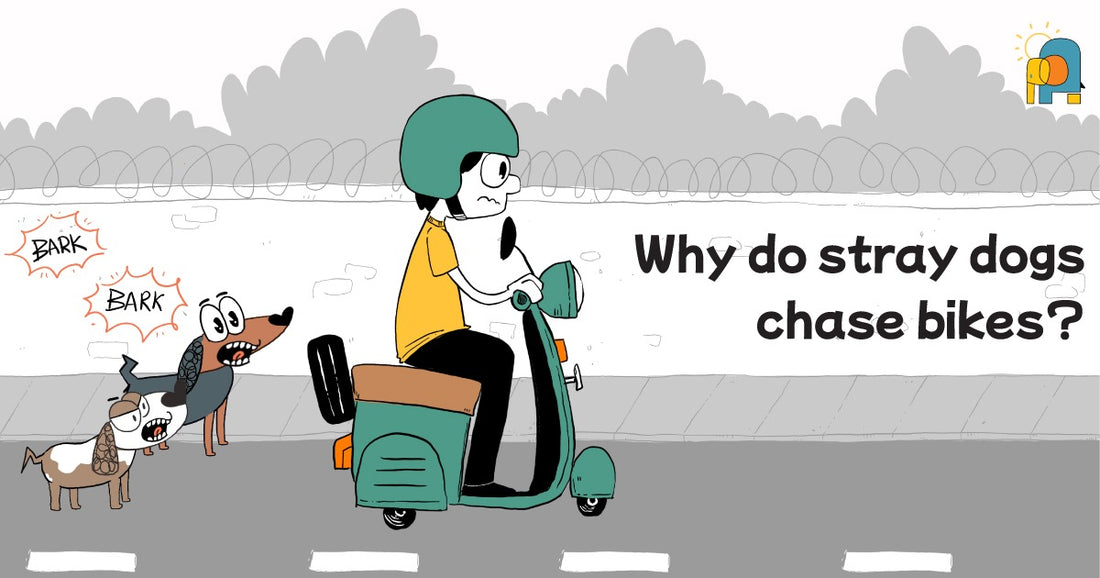Have you ever had a moment where a dog suddenly started running after your bike, barking like it’s on a mission? It’s common, especially on Indian roads, and can often leave you feeling startled or even scared. But why do they do it? Is it anger, excitement, or something else entirely?
The truth is, stray dogs have reasons for their actions. Some of these are rooted in their instincts, while others are tied to the environment they live in. Let’s look at why dogs tend to chase bikes and how we can handle it calmly and safely.
1. It’s Their Natural Instinct
Dogs, even strays, are wired to chase things that move fast. In the wild, they’re natural hunters. When they see a bike zoom past, their brains interpret it as a prey-like movement. The combination of speed, sound, and motion triggers an automatic response.
To them, the bike resembles something running away—something they want to catch. It’s not personal; it’s just their predatory instinct kicking in.
2. Fear or Excitement
Not all dogs chase bikes out of aggression. Sometimes, it’s fear or confusion caused by the loud growling noise of the engine or the flashing headlights. Imagine sitting peacefully, and suddenly, a strange sound roars past you. Naturally, you’d feel startled, right?
Dogs feel the same way. Some get scared and react by chasing the bike to “defend” themselves or drive it away. On the flip side, certain dogs get overly excited by sounds or movement, especially younger or more playful ones. They see the bike as something fun to run after.
3. Protecting Their Territory
Dogs are territorial creatures, much like us guarding our homes. They have invisible “boundaries” that they protect at all costs. If a moving bike enters what they see as their space, they may bark or chase after it to send a message—“Hey, this is my area. You’re not welcome here!”
I’ve seen this firsthand in my neighborhood. There’s a group of stray dogs near the corner of my street. Every evening, when bikes pass by, they bark furiously and run a few steps before stopping. Once the bike leaves, they return to sitting calmly. It’s not aggression; it’s simply their way of protecting their turf.
4. Past Experiences
Just like us, dogs remember negative experiences. If a dog has been hurt, chased, or scared by a bike in the past, they might associate all bikes with danger. So, when they see another one, they instinctively react with anger or fear.
For instance, I remember a dog named Raju in my friend’s neighborhood. He was hit by a speeding bike when he was young. Ever since, he would bark loudly and chase after any two-wheeler that came too close. It wasn’t because he was aggressive—it was his way of saying, “Stay away!”
5. How to Handle Dogs Chasing Your Bike
Being chased by a dog can be nerve-wracking, especially if it’s unexpected. But panicking can make things worse. Here are a few tips to handle the situation safely:
Stay Calm and Don’t Speed Up
When a dog starts chasing, your first instinct might be to speed up or make sudden moves. However, that can make the dog more aggressive. Instead, stay calm and ride at a steady pace. Most of the time, they lose interest after a while.
Avoid Yelling or Throwing Objects
Shouting at the dog or throwing things can provoke it further. Dogs might interpret this as a threat, and their aggression could escalate.
Build Trust with Local Strays
If you pass by the same area regularly, try building trust with the stray dogs. Carry some biscuits or treats with you and offer them occasionally (from a safe distance). When dogs recognize you as non-threatening, they’re far less likely to chase you.
I’ve seen this work beautifully in my own area. A delivery guy who passed by daily began tossing treats to the local strays. Within a week, the dogs stopped barking at him and would wag their tails instead!
Use Your Bike as a Shield if Needed
If the dogs get aggressive or you’re cornered, don’t run or panic. Use your bike as a barrier between you and the dogs, and try to distract them by shouting for help or slowly backing away.
Ask for Local Help
If you notice dogs becoming overly aggressive in certain areas, inform local animal welfare organizations or volunteers. They often help stray dogs by feeding, vaccinating, and even calming their behavior through kindness.
Final Thoughts
The next time a stray dog chases your bike, remember—most of the time, they are reacting to instinct or fear, not attacking you as a person. By staying calm and composed, you can avoid escalating the situation.
Also, try to understand life from the perspective of these dogs. They live on the streets, face constant noise, and sometimes have difficult experiences with humans or vehicles. A little compassion and understanding can go a long way.
If we treat stray dogs with kindness, build trust, and ensure they feel safe, they will respond with equal warmth. After all, dogs are creatures of love—they just need to feel it first.

